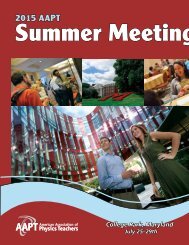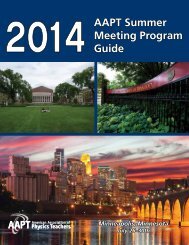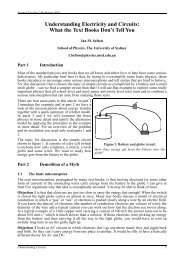final-program-12-23-14-3
final-program-12-23-14-3
final-program-12-23-14-3
Create successful ePaper yourself
Turn your PDF publications into a flip-book with our unique Google optimized e-Paper software.
Monday morning<br />
64<br />
Session DD: Single Photon<br />
Detectors<br />
DD01:<br />
Location: Nautilus Hall 3<br />
Sponsor: Committee on Apparatus<br />
Date: Monday, January 5<br />
Time: 11 a.m.–<strong>12</strong>:10 p.m.<br />
Presider: Gabe Spalding<br />
11-11:30 a.m. The Weirdness of Quantum Mechanics, One<br />
Photon at a Time<br />
Invited – Theresa W. Lynn, Harvey Mudd College, 301 Platt Blvd., Claremont,<br />
CA 91711-5990; lynn@hmc.edu<br />
Richard Haskell, Harvey Mudd College<br />
Spontaneous parametric down conversion provides a simple and<br />
affordable source of entangled photon pairs, and single-photon counting<br />
modules are increasingly affordable tools for detecting individual<br />
photons with high efficiency. These technologies allow undergraduates<br />
to gain hands-on experience with some of the most important<br />
—and strangest—aspects of quantum mechanics. Using entangled<br />
photon pairs as a source of heralded single photons, students demonstrate<br />
that light is quantized by observing anticoincidence between<br />
photon counts on the two output ports of a beam splitter. Then,<br />
replacing the simple beam splitter with a Mach-Zehnder interferometer,<br />
students observe single photons interfering with themselves! The<br />
interference is destroyed by which-way information but revived when<br />
which-way information is “erased,” demonstrating a quantum eraser.<br />
Finally, by measuring the polarizations of entangled photon pairs,<br />
students observe the violation of local realism in quantum mechanics.<br />
An hour’s worth of data easily violates Bell’s inequality by more than<br />
100 standard deviations.<br />
DD02: 11:30 a.m.-<strong>12</strong> p.m. Photon Counting Instrumentation in<br />
Quantum Optics and Nano-Optics Teaching Laboratory*<br />
Invited – Svetlana G. Lukishova, The Institute of Optics, University of<br />
Rochester, 275 Hutchison Road, Rochester, NY <strong>14</strong>627-0186;<br />
lukishova@gmail.com<br />
I will outline my experience of using single-photon counting<br />
avalanche photodiode modules (Perkin Elmer) and low-light level,<br />
cooled EM-CCD cameras of Andor Technology in undergraduate<br />
teaching experiments on quantum optics and nano-optics. We<br />
developed four teaching laboratory experiments on generation and<br />
characterization of single and entangled photons: Lab. 1. Quantum<br />
entanglement and Bell’s inequalities. Polarization and angular momentum<br />
of light. Discussion of quantum cryptography, quantum teleportation<br />
and quantum computing; Lab. 2. Single-photon interference<br />
(Young’s double slit and Mach-Zehnder interferometers), quantum<br />
eraser. Low-light level EM-CCD cameras and sources of noise. Lab. 3<br />
Single-photon source: Confocal microscope imaging of single-emitter<br />
fluorescence, atomic force microscope imaging of nano-emitter topography.<br />
Nanoplasmonics, photonic bandgap materials and metamaterials.<br />
Lab. 4. Single-photon source: Hanbury Brown and Twiss setup.<br />
Photon antibunching. Single-photon counting avalanche photodiode<br />
modules. Electronics for photon counting instrumentation.<br />
*This activity was supported by four NSF Grants (Material-Research-Instrumentation,<br />
CCLI Phase I, CCLI Phase II, NUE <strong>program</strong>).<br />
DD03: <strong>12</strong>-<strong>12</strong>:10 p.m. Quantum Mechanical Ghost Interference<br />
Contributed – David P. Jackson, Dickinson College, Department of<br />
Physics, Carlisle, PA 17013-2896; jacksond@dickinson.edu<br />
Quantum-mechanical ghost interference is a phenomenon in which<br />
a double-slit interference pattern is observed without sending light<br />
through a double-slit aperture. This phenomenon makes use of a<br />
source of entangled photons that produces two beams of light (the<br />
signal and idler beams). When placing a double-slit aperture in the<br />
signal beam, an interference pattern is not observed in the signal<br />
beam unless the signal and idler beams are observed in coincidence.<br />
DE01:<br />
Remarkably, an interference pattern can also be observed in the idler<br />
beam even though the double-slit aperture is in the signal beam. In<br />
this talk I will give a brief overview of our attempt to perform such an<br />
experiment with undergraduate students.<br />
Session DE: Mentoring Newly<br />
Graduated Teachers to Improve<br />
Retention<br />
Location: Nautilus Hall 4<br />
Sponsor: Committee on Teacher Preparation<br />
Date: Monday, January 5<br />
Time: 11 a.m.–<strong>12</strong>:40 p.m.<br />
Presider: David Rosengrant<br />
11-11:30 a.m. Addressing Early Career Physics Teacher<br />
Attrition by Developing Professional Vision<br />
Invited – Gregory Rushton, Kennesaw State University, 1000 Chastain-<br />
Road #<strong>12</strong>03, Kennesaw, GA 30<strong>14</strong>4-5591; grushton@kennesaw.edu<br />
Brett Criswell University of Kentucky<br />
David Rosentgrant, Michelley Dean, Justin Polizzi, Kennesaw State<br />
University<br />
Through a five-year, NSF supported professional development<br />
<strong>program</strong> that seeks to recruit, prepare and retain STEM professionals<br />
in secondary physics teaching careers, we are studying how the<br />
formation of their professional identity influences their dispositions<br />
towards implementing reform-based practices and their decision to<br />
remain in the K<strong>12</strong> profession. We have been developing intentional<br />
experiences during the pre-service and induction phases using Gee’s<br />
identity framework and Goodwin’s notion of professional vision as the<br />
lenses through which we see the teachers’ development as competent<br />
and active members of the teaching community of practice. Herein<br />
we describe the theory base for our study, the research methods<br />
for studying the teachers’ identity formation and progress, and the<br />
nature of the professional development experiences that we hope will<br />
positively impact their views of using research-based practices in their<br />
classrooms and their choice with respect towards remaining in the<br />
career for an extended period of time.<br />
DE02: 11:30 a.m.-<strong>12</strong> p.m. Friday Night Physics: Learning<br />
Communities to Improve Teacher Retention<br />
Invited – Danielle Buggé, Rutgers University, 10 Seminary Place, New<br />
Brunswick, NJ 08901-1183; danielle.bugge@gse.rutgers.edu<br />
Eugenia Etkina. Rutgers University<br />
A feeling if isolation is one of the reasons for teachers to leave the<br />
profession. Thus a strong physics teacher preparation <strong>program</strong> should<br />
not only prepare pre-service teachers to implement high-quality<br />
instruction but must also support them after graduation. A community<br />
of graduates can help provide this support naturally. Experienced<br />
teachers share experiences with the new teachers, the new teachers<br />
provide a constant support of energy and enthusiasm and both<br />
groups grow together solving common problems. What does it take<br />
to create and sustain such community What effects does it have on<br />
the participants The goal of this talk is to answer these questions and<br />
to provide helpful hints for those who are interested in organizing<br />
similar communities.<br />
DE03: <strong>12</strong>-<strong>12</strong>:30 p.m. Collaborative PER as a Form of Teacher<br />
Induction and Mentoring*<br />
Invited – Emily Quinty, University of Colorado Boulder, 249 UCB Boulder,<br />
CO 80309-0249; emily.quinty@gmail.com<br />
Valerie K. Otero<br />
The Teacher Research Teams model improves teacher retention by<br />
increasing job satisfaction through the intellectually engaging activity<br />
WINTER MEETING<br />
JANUARY 3-6<br />
2015<br />
SAN DIEGO, CA






